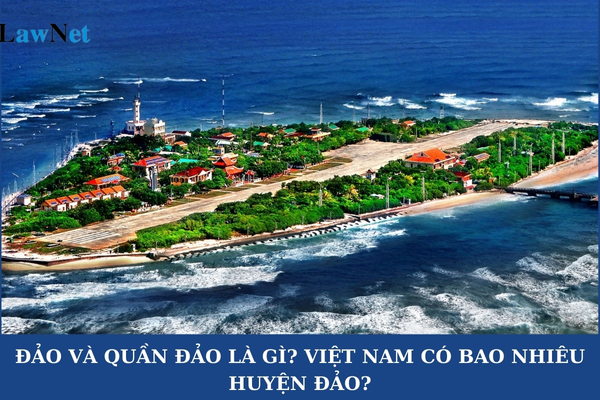What are islands and archipelagos? How many island districts does Vietnam have?
What are islands and archipelagos? How many island districts does Vietnam have?
* What are islands and archipelagos?
According to Clause 1, Article 19 of the Law of the Sea of Vietnam 2012, islands and archipelagos are defined as follows:
- An island is a naturally formed area of land, surrounded by water, which remains above water during high tide.
- An archipelago is a group of islands, including parts of islands, contiguous waters, and other related natural components closely interconnected.
Furthermore, the Law of the Sea of Vietnam 2012 also asserts that islands and archipelagos under Vietnam's sovereignty are inseparable parts of Vietnam's territory.
* How many island districts does Vietnam have?
Vietnam has a total of 12 island districts, spreading from north to south. Each island district plays an important role in protecting sovereignty, developing the maritime economy, and tourism. Below is the list of island districts in Vietnam:
- Co To Island District (Quang Ninh)
- Van Don Island District (Quang Ninh)
- Bach Long Vi Island District (Hai Phong)
- Cat Hai Island District (Hai Phong)
- Ly Son Island District (Quang Ngai)
- Hoang Sa Island District (Da Nang)
- Phu Quy Island District (Binh Thuan)
- Con Dao Island District (Ba Ria - Vung Tau)
- Truong Sa Island District (Khanh Hoa)
- Kien Hai Island District (Kien Giang)
- Phu Quoc Island District (Kien Giang)
- Tho Chau Island District (Kien Giang)

What are islands and archipelagos? How many island districts does Vietnam have? What are requirements for assessment of educational outcomes for the subject of History and Geography at the lower secondary level in Vietnam? (Image from the Internet)
What is the general orientation of the teaching methods for History and Geography at the lower secondary school level in Vietnam?
Based on Section VI of the General Education Program for History and Geography at the lower secondary school level, issued with Circular 32/2018/TT-BGDDT, the general orientation of teaching methods for History and Geography at this level is as follows:
- Emphasize the learning role of students, promoting their positivity, proactiveness, creativity; overcoming the one-way, imposed rote teaching style; focus on training skills to apply knowledge into practice, cultivating learning methods, and self-study skills so that students can further explore and expand their cultural knowledge needed for themselves.
- Flexibly and creatively apply teaching methods and techniques in line with the goals, educational content, student audience, and specific conditions. Combine traditional teaching methods (lectures, discussions,...) by enhancing the positivity and proactivity of students with an increase in the use of advanced teaching methods that emphasize the student's role (discussions, debates, role-playing, project-based learning,...).
- Diversify and flexibly use different teaching organization methods: Combine individual learning, group learning, classroom learning, on-field learning, project-based learning,... Pay attention to teaching methods that are characteristic of the subject.
- Enhance the application of information and communication technology, using teaching equipment reasonably and effectively such as: models, historical pictures, photos, audio tapes of historical figures' speeches,...; maps, diagrams, statistics, comparisons,...; video films; study cards with resources; educational software,... to illustrate the teacher’s lectures and support learning activities of students.
What are requirements for assessment of educational outcomes for the subject of History and Geography at the lower secondary level in Vietnam?
Based on Section VI of the General Education Program for History and Geography at the lower secondary school level issued with Circular 32/2018/TT-BGDDT, the assessment of educational outcomes in this program must meet the following requirements:
- The assessment aim is to provide accurate, timely, valuable information on the level of meeting the required outcomes of the History and Geography program and the progress of students to guide and adjust teaching activities of teachers and learning activities of students.
- The assessment basis is the requirement of achieving key qualities, general competencies, and specific competencies in history and geography as specified in the General Program and the History and Geography program.
- In addition to theoretical content, it is necessary to enhance the assessment of students’ skills such as: working with maps, atlasses, diagrams, data tables, pictures, observing, collecting, processing, and systematizing information, using outdoor learning tools, utilizing information and communication technology in learning,... Assess the ability to apply knowledge to specific situations, rather than focusing on testing the ability to regurgitate historical or geographical knowledge.
- Diversify assessment forms, enhance regular assessments for all students through various forms: assessment through classroom activity observation; assessment through learning portfolios, learning products;
Assessment through project reports, practical reports, presentations on learning task outcomes. Provide opportunities for students to participate in the educational outcome assessment process.
- Educational outcomes are assessed qualitatively and quantitatively through regular, periodic assessment, thus aggregating an overall assessment of students’ qualities, competencies, and progress.

